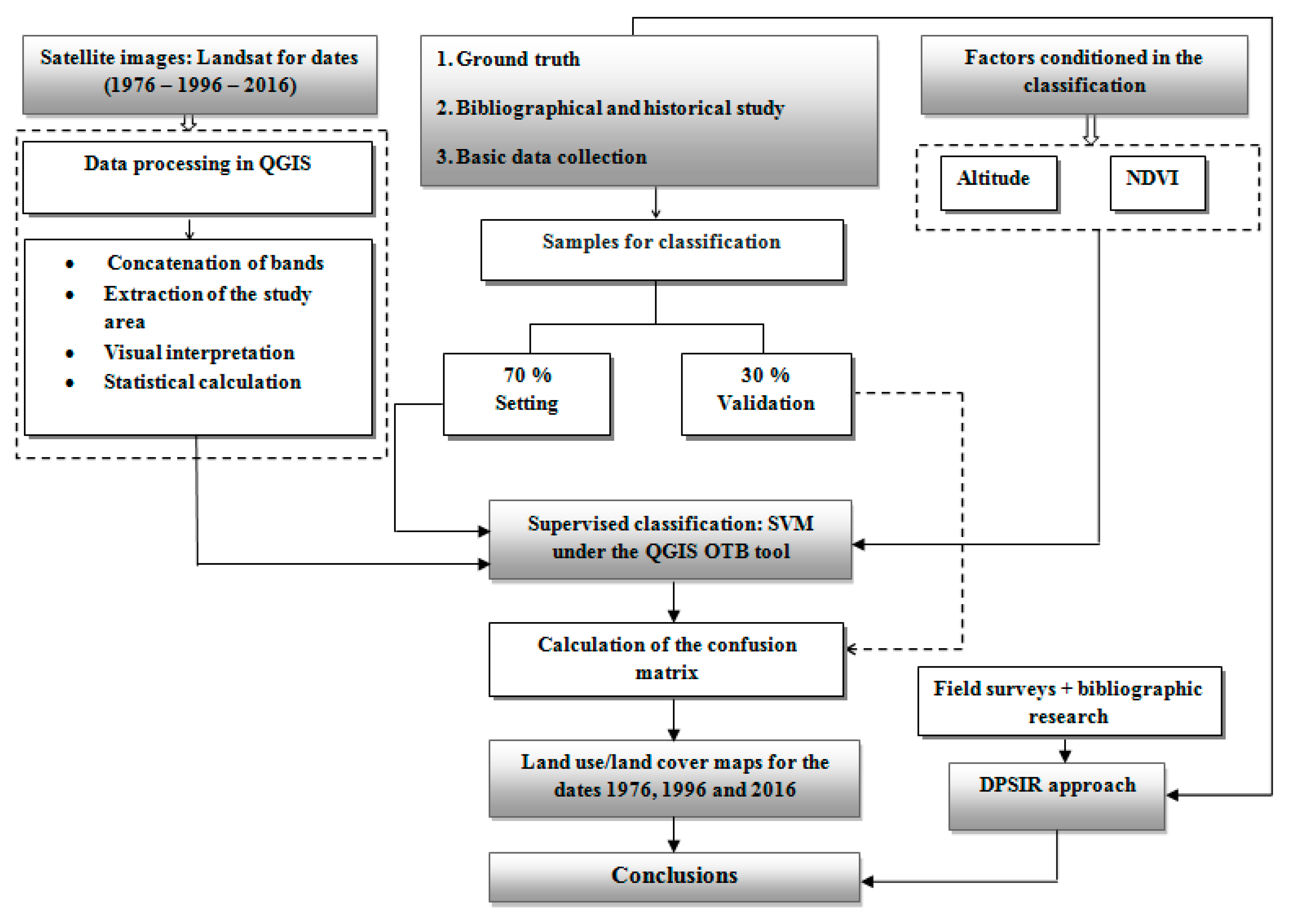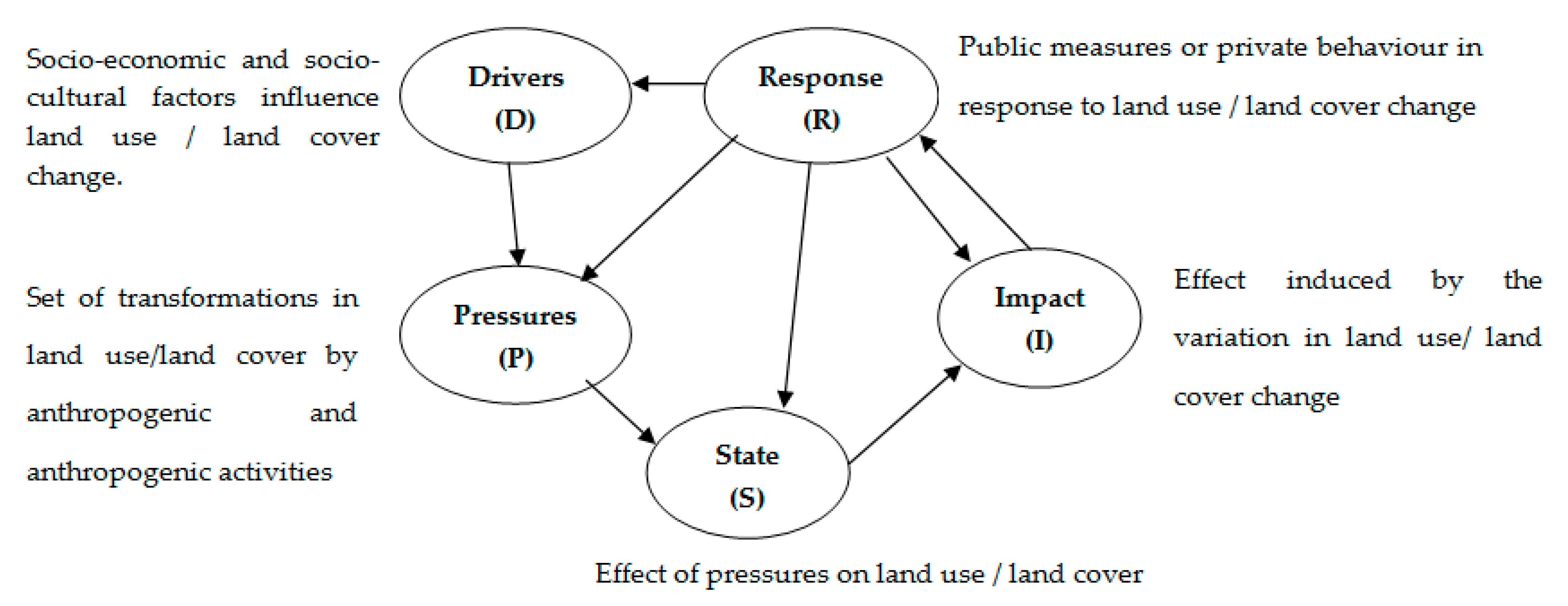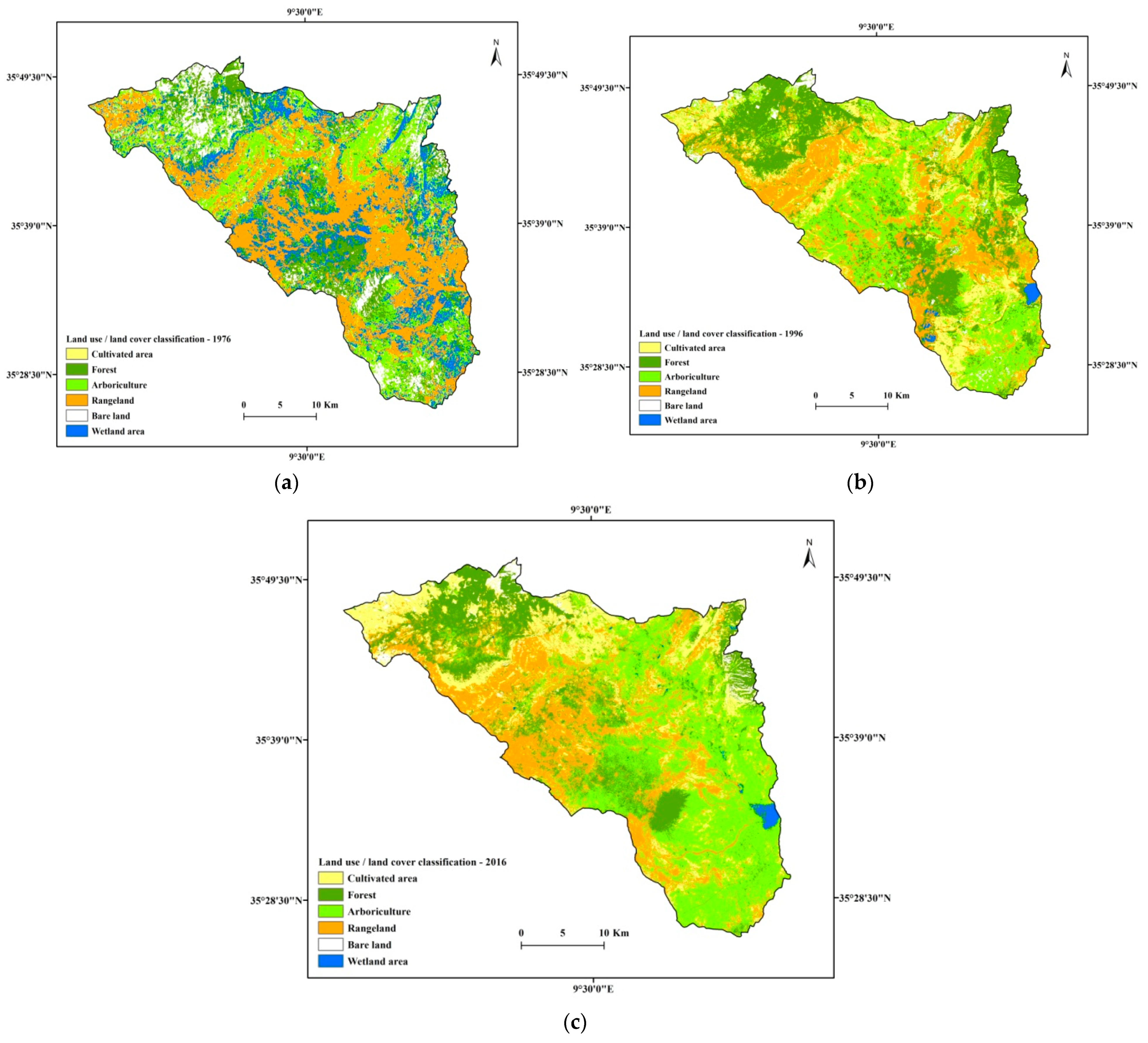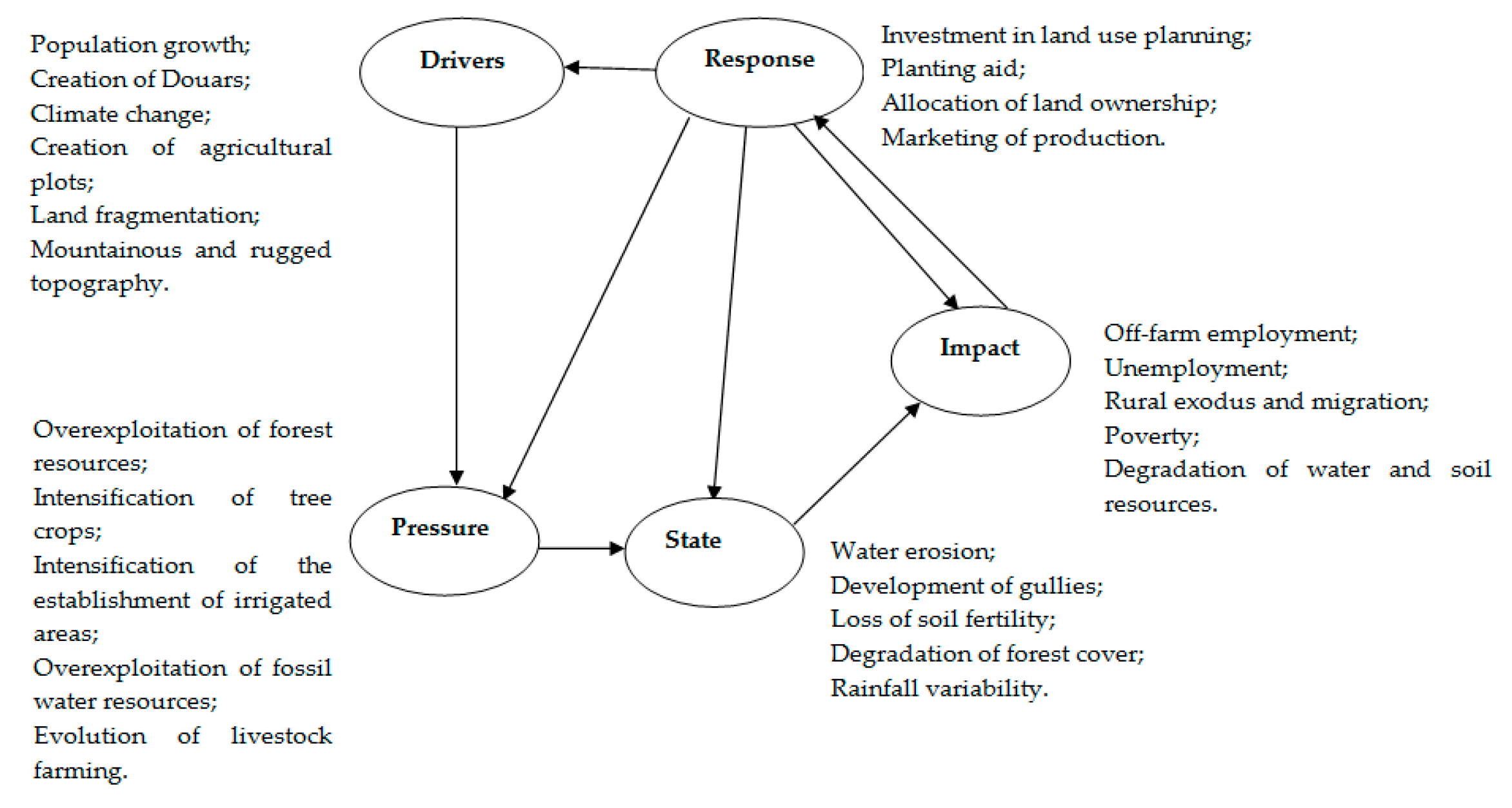Drivers of Long-Term Land-Use Pressure in the Merguellil Wadi, Tunisia, Using DPSIR Approach and Remote Sensing
Abstract
1. Introduction
2. Materials and Methods
2.1. Study Area
2.2. Data Used
2.3. Land Use—Land Cover Classification
2.4. Accuracy Assessment
2.5. Household Surveys
2.6. Indicator-Based Approach
3. Results
3.1. Land Use/Land Cover Dynamics
3.2. Adaptation of the DSPIR Approach in the Merguellil Wadi Basin
3.2.1. Drivers of Land Use/Land Cover Change
3.2.2. Pressures Due to Land Use/Land Cover Change
3.2.3. States Perceived Due to Land Use/Land Cover Change
3.2.4. Impacts of Land Use/Land Cover Change
3.2.5. Responses of Land Use/Land Cover Change
3.3. Relationship between Land Use Land Cover Types of Culture and the DPSIR Approach
4. Discussion
4.1. Land Use Change
4.2. DPSIR Indicators Related to Land Use Change
4.2.1. Drivers Linked to Land Use Change
4.2.2. Pressures Linked to Land Use Dynamics
4.2.3. Status Linked to Land Use Dynamics
4.2.4. Impacts Linked to the Dynamics of Land Use
4.2.5. Responses Linked to Land Use Dynamics
5. Conclusions
Author Contributions
Funding
Institutional Review Board Statement
Informed Consent Statement
Data Availability Statement
Conflicts of Interest
References
- Gedefaw, A.; Atzberger, C.; Bauer, T.; Agegnehu, S.; Mansberger, R. Analysis of land cover change detection in Gozamin District, Ethiopia: From remote sensing and DPSIR perspectives. Sustainability 2020, 12, 4534. [Google Scholar] [CrossRef]
- Islam, K.; Jashimuddin, M.; Nath, B.; Nath, T.K. Land use classification and change detection by using multi-temporal remotely sensed imagery: The case of Chunati wildlife sanctuary, Bangladesh. Egypt. J. Remote Sens. Space Sci. 2018, 21, 37–47. [Google Scholar] [CrossRef]
- Bruno, M.F.; Saponieri, A.; Molfetta, M.G.; Damiani, L. The DPSIR approach for coastal risk assessment under climate change at regional scale: The case of apulian coast (Italy). J. Mar. Sci. Eng. 2020, 8, 531. [Google Scholar] [CrossRef]
- Reid, R.S.; Kruska, R.L.; Muthui, N.; Taye, A.; Wotton, S.; Wilson, C.J.; Mulatu, W. Land-use and land-cover dynamics in response to changes in climatic, biological and socio-political forces: The case of southwestern Ethiopia. Landsc. Ecol. 2000, 15, 339–355. [Google Scholar] [CrossRef]
- Nwaogu, C.; Okeke, J.; Adu, S.A.; Babine, E.; Pechanec, V. Land use—Land cover change and soil-gully erosion relationships: A study of Nanka, South-Eastern Nigeria using geoinformatics. In Dynamics in GIscience; Springer: Cham, Switzerland, 2017; pp. 305–319. [Google Scholar] [CrossRef]
- Rawat, J.; Kumar, M. Monitoring land use/cover change using remote sensing and GIS techniques: A case study of Hawalbagh block, district Almora, Uttarakhand, India. Egypt. J. Remote Sens. Space Sci. 2015, 18, 77–84. [Google Scholar] [CrossRef]
- Betrua, T.; Tolera, M.; Sahleb, K.; Kassac, H. Trends and drivers of land use/land cover change in Western Ethiopia. Appl. Geogr. 2019, 104, 83–93. [Google Scholar] [CrossRef]
- Schürmann, A.; Kleemann, J.; Fürst, C.; Teucher, M. Assessing the relationship between land tenure issues and land cover changes around the Arabuko Sokoke Forest in Kenya. Land Use Policy 2020, 95, 104625. [Google Scholar] [CrossRef]
- Valentin, C.; Poesen, J.; Li, Y. Gully erosion: Impacts, factors and control. Catena 2005, 63, 132–153. [Google Scholar] [CrossRef]
- Taruvinga, K. Gully Mapping Using Remote Sensing: Case Study in Kwazulu Natal, South Africa. Ph.D. Thesis, University of Waterloo, Waterloo, ON, Canada, 2008. Available online: https://uwspace.uwaterloo.ca/bitstream/handle/10012/4216/Kanyadzo_Taruvinga_Thesis.pdf?sequence=1 (accessed on 14 October 2021).
- Bouaziz, M.; Wijaya, A.; Gloaguen, R. Remote gully erosion mapping using aster data and geomorphologic analysis in the Main Ethiopian Rift. Geo-Spat. Inf. Sci. 2011, 14, 246–254. [Google Scholar] [CrossRef]
- Desprats, J.; Raclot, D.; Rousseau, M.; Cerdan, O.; Garcin, M.; Le Bissonnais, Y.; Ben Slimane, A.; Fouche, J.; Monfort-Climent, D. Mapping linear erosion features using high and very high resolution satellite imagery. Land Degrad. Dev. 2013, 24, 22–32. [Google Scholar] [CrossRef]
- Karami, A.; Khoorani, A.; Noohegar, A.; Shamsi, S.R.F.; Moosavi, V. Gully erosion mapping using object-based and pixel-based image classification methods. Environ. Eng. Geosci. 2015, 21, 101–110. [Google Scholar] [CrossRef]
- Pourghasemi, H.R.; Yousefi, S.; Kornejady, A.; Cerdà, A. Performance assessment of individual and ensemble data-mining techniques for gully erosion modeling. Sci. Total Environ. 2017, 609, 764–775. [Google Scholar] [CrossRef]
- Rasool, R.; Fayaz, A.; Shafiq, M.U.; Singh, H.; Ahmed, P. Land use land cover change in Kashmir Himalaya: Linking remote sensing with an indicator based DPSIR approach. Ecol. Indic. 2021, 125, 107447. [Google Scholar] [CrossRef]
- OCDE. OCDE Core Set of Indicators for Environmental Performance Reviews; OCDE: Paris, France, 1993. [Google Scholar]
- EEA. The Changing Faces of Europe’s Coastal Areas; Number No. 6 in EEA Report; European Environment Agency: Copenhagen, Denmark, 2006. [Google Scholar]
- Desta, H.; Fetene, A. Land-use and land-cover change in Lake Ziway watershed of the Ethiopian Central Rift Valley Region and its environmental impacts. Land Use Policy 2020, 96, 104682. [Google Scholar] [CrossRef]
- Hamza, M. Projet de Développement Agricole du Gouvernorat de Kairouan (Ressources en eau); Rapp. Tech. D.G.R.E.: Tunis, Tunisia, 2006; p. 90. [Google Scholar]
- Bouzaiane, S.; Lafforgue, A. Monographie hydrologique des oueds Zeroud et Merguellil; D.G.R.E-ORSTOM: Tunis, Tunisia, 1986; p. 1058. [Google Scholar]
- Haddaji, F.; Messoudi, N.; Saidani, M.; Selmi, T.; Saidi, I.; Braiki, H. Diagnostic Territorial, Participative et Systémique: Zone d’Intervention de Kairouan—El Alaa; Rapp Int.: Tunis, Tunisia, 2020; 70p. [Google Scholar]
- MARHP. Projet de Développement Agricole du Gouvernorat de Kairouan; Rapport Interne; Ministère de L’agriculture, des Ressources Hydrauliques et de la Pêche: Tunis, Tunisia, 1985. [Google Scholar]
- Burte, J.; Leauthaud, C.; Augusseaux, X. Guide Audit Territorial Participatif Programme d’Adaptation au changement Climatique des Territoires vulnérables de Tunisie (PACTE); Rapp. Expertise, CIRAD: Montpellier, France, 2017; 100p. [Google Scholar]
- Leduc, L.; Beji, R.; Calvez, R. Les Ressources en eau du Barrage d’el Haouareb et des Nappes Adjacentes, Vallée du Merguellil, Tunisie Centrale. In Proceedings of the Séminaire PCSI “Gestion intégrée de l’eau au sein d’un bassin versant”, session Présentation détaillée d’un terrain du Sud, la gestion du bassin du Merguellil (Tunisie), Montpellier, France, 2–3 December 2003. [Google Scholar]
- Kingumbi, A.; Besbes, M.; Bourges, J.; Garetta, P. Évaluation des transferts entre barrage et aquifères par la méthode de bilan d’une retenue en zone semi-aride. Cas d’El Haouareb en Tunisie centrale. Rev. des Sci. de l’eau 2004, 17, 213–225. [Google Scholar] [CrossRef][Green Version]
- Khemiri, K.; Jebari, S.; Berndtsson, R.; Maalel, K. Is climate or direct human influence responsible for discharge decrease in the Tunisian Merguellil Basin? Water 2021, 13, 2748. [Google Scholar] [CrossRef]
- Ogilvie, A.; Le Goulven, P.; LeDuc, C.; Calvez, R.; Mulligan, M. Réponse hydrologique d’un bassin semi-aride aux événements pluviométriques et aménagements de versant (bassin du Merguellil, Tunisie centrale). Hydrol. Sci. J. 2016, 61, 441–453. [Google Scholar] [CrossRef]
- INM. Annuaire Météorologique de la Tunisie; Publication de l’Institut National de la Météorologie: Tunis, Tunisia, 2018. [Google Scholar]
- Latham, J.; Cumani, R.; Rosati, I.; Bloise, M. FAO Global Land Cover (GLCSHARE) Beta-Release 1.0 Database; Division Land and Water: Rome, Italy, 2014. [Google Scholar]
- DGF. Direction Générale des Forêts, Inventaire des Forêts par Télédétection—Résultat du Deuxième Inventaire Forestier et Pastoral National Ministère de la Défense Nationale, Ministère de l’Agriculture des Ressources Hydrauliques et de la Pêche et Ministère de l’Enseignement Supérieur et de la Recherche Scientifique; CNUDST: Tunis, Tunisia, 2010; 195p. [Google Scholar]
- PR-OSCAR. Projet—Zone D’intervention El Ala; Rapport Interne INRGREF: Tunis, Tunisia, 2019. [Google Scholar]
- Zhu, L. The Institutional Environment for B2B E-Commerce Adoption. Ph.D. Thesis, University of Arizona, Tucson, AZ, USA, 2008; 320p. [Google Scholar]
- Nguyen, T.C.; Nguyen, P.; Nguyen, Q.P.; Phan, T.M.H. Application of DPSIR framework to access environmental impact of white limestone mining and processing in Luc Yen, Yen Bai province. J. Vietnam. Environ. 2018, 9, 235–239. [Google Scholar] [CrossRef]
- Tastle, W.J.; Wierman, M.J. Consensus and dissention: A measure of ordinal dispersion. Int. J. Approx. Reason. 2007, 45, 531–545. [Google Scholar] [CrossRef]
- Yule, G.U.; Pearson, K. Early Statistical Papers; University Press: Cambridge, UK, 1948. [Google Scholar]
- Awuh, M.E.; Japhets, P.O.; Officha, M.C.; Okolie, A.O.; Enete, I.C. A Correlation Analysis of the Relationship between Land Use and Land Cover/Land Surface Temperature in Abuja Municipal, FCT, Nigeria. J. Geogr. Inf. Syst. 2019, 11, 44–55. [Google Scholar] [CrossRef]
- Shao, Z.; Fu, H.; Fu, P.; Yin, L. Mapping Urban Impervious Surface by Fusing Optical and SAR Data at the Decision Level. Remote Sens. 2016, 8, 945. [Google Scholar] [CrossRef]
- PIF. Programme d’Investissement Forestier. In Plan d’Investissement; MARHP: Ariana, Tunisia, 2016. [Google Scholar]
- GIZ. Etude de la filière des céréales dans le Gouvernorat du Kairouan-Projet. In Promotion de l’Agriculture Durable et du Développement rural-Filière Céréales Dans le Gouvernorat de Kairouan; Rapport Final; Deutsche Gesellschaft für Internationale Zusammenarbeit (GIZ) GmbH MARHP: Ariana, Tunisia, 2014; 45p. [Google Scholar]
- Khemiri, K.; Jebari, S. Étude comparative de deux modèles d’évaluation de l’érosion hydrique RUSLE et MUSLE dans les bassins versants du semi-aride Tunisien. Cah. Agric. 2021, 30, 7. [Google Scholar] [CrossRef]
- Turner, A. Population priorities: The challenge of continued rapid population growth. Philos. Trans. R. Soc. Lond. B Biol. Sci. 2009, 364, 2977–2984. [Google Scholar] [CrossRef]
- INS. Institut National de la Statistique-Recensement Général de la Population et de l’Habitat-Tunisie; Rapport Interne; INS: Tunis, Tunisia, 2014. [Google Scholar]
- INS. Institut National de la Statistique-Recensement Général de la Population et de l’habitat-Tunisie; Rapport Interne; INS: Tunis, Tunisia, 2016. [Google Scholar]
- Jouini, M. Evaluation Environnementale des Pratiques Agricoles et des Aménagements de Conservation par ACV: Cas du Bassin Versant Merguellil de la Tunisie Centrale. Ph.D. Thesis, Agro—Montpellier Sup. Agro. Institut—Nat. Agr. of Tunisia, Tunis, Tunisia, 2019. [Google Scholar]
- UNFCCC. United Nations Climate Change. Annual Report. 2019. Available online: https://unfccc.int/sites/default/files/resource/unfccc_annual_report_2019.pdf (accessed on 5 October 2021).
- Jebari, S.; Berndtsson, R.; Bahri, A.; Boufaroua, M. Spatial soil loss risk and reservoir siltation in semi-arid Tunisia. Hydrol. Sci. J. 2010, 55, 121–137. [Google Scholar] [CrossRef]
- Mantyka-Pringle, C.S.; Visconti, P.; Di Marco, M.; Martin, T.; Rondinini, C.; Rhodes, J. Climate change modifies risk of global biodiversity loss due to land-cover change. Biol. Conserv. 2015, 187, 103–111. [Google Scholar] [CrossRef]
- Eitelberg, D.A.; van Vliet, J.; Doelman, J.C.; Stehfest, E.; Verburg, P. Demand for biodiversity protection and carbon storage as drivers of global land change scenarios. Glob. Environ. Chang. 2016, 40, 101–111. [Google Scholar] [CrossRef]
- Masum, K.M.; Mansor, A.; Sah, S.A.M.; Lim, H.S. Effect of differential forest management on land-use change (LUC) in a tropical hill forest of Malaysia. J. Environ. Manag. 2017, 200, 468–474. [Google Scholar] [CrossRef] [PubMed]
- Géroudet, C. Démographie et Histoire Agraire du Bassin Versant du Merguellil—Partie I: Histoire du Peuplement et Histoire Agraire; IInstitute national agronomique Paris-Grignon: Paris, France; Institue de Recherche Pour le Développement et International Water Management Institue IRD & IWMI: Anand, India, 2004; Available online: http://www.iwmi.cgiar.org/assessment/files/word/ProjectDocuments/Merguellil/partie2.pdf (accessed on 5 October 2021).
- GIZ. Rapport National—EZ Trifft Wissenschaft. Deutsche Gesellschaft für Internationale Zusammenarbeit (GIZ) GmbH Sektorvorhaben Politikberatungim Bereich Wasser. 2007. Available online: https://wocatpedia.net/images/2/2e/GIZ_%282007%29_EZ_trifft_Wissenschaft.pdf (accessed on 5 October 2021).
- MARHP. Projet de Développement Agricole du Gouvernorat de Kairouan (Ressources en eau); Rapp. Tech.; Ministère de l’Agriculture, des Ressources Hydrauliques et de la pêche: Tunis, Tunisia, 2017. [Google Scholar]






| Land Use/Land Cover Class | Description |
|---|---|
| Cultivated area | Herbaceous crops; woody crops; mixed herbaceous and woody crops. |
| Forest | Tree plants with a cover of 10% or more. Other types of plants (shrubs and/or grasses) may be present, even at a higher density than trees. |
| Arboriculture | Woody plants (trees and/or shrubs) may be present assuming that their cover is less than 10%. |
| Rangeland | Natural herbaceous plants (grasslands, steppes) with a cover of 10% or more, independent of different human and/or animal activities, such as grazing. |
| Bare land | Natural abiotic surfaces (bare soil, sand, rocks, etc.) where natural vegetation is absent or almost absent (cover less than 2%). |
| Wetland area | Flooded areas, salt water, fresh water (sebkha, wadi course). |
| 1976 | |||||||
| Land use/Land cover | Cultivated area | Forest | Arboriculture | Rangeland | Bare land | Wetland area | Total |
| Cultivated area | 2254 | 4 | 163 | 142 | 0 | 5 | 2568 |
| Forest | 12 | 1870 | 445 | 0 | 5 | 7 | 2339 |
| Arboriculture | 514 | 92 | 1950 | 176 | 1 | 23 | 2756 |
| Rangeland | 476 | 0 | 246 | 1097 | 0 | 43 | 1862 |
| Bare land | 86 | 376 | 222 | 14 | 850 | 0 | 1548 |
| Wetland area | 82 | 38 | 384 | 59 | 0 | 5840 | 6403 |
| Total | 3424 | 2380 | 3410 | 1488 | 856 | 5918 | |
| 1996 | |||||||
| Land use/Land cover | Cultivated area | Forest | Arboriculture | Rangeland | Bare land | Wetland area | Total |
| Cultivated area | 2682 | 25 | 15 | 209 | 0 | 0 | 2931 |
| Forest | 112 | 4760 | 274 | 63 | 19 | 0 | 5228 |
| Arboriculture | 1034 | 157 | 1926 | 350 | 10 | 0 | 3477 |
| Rangeland | 325 | 183 | 101 | 2326 | 64 | 0 | 2999 |
| Bare land | 142 | 31 | 9 | 0 | 112 | 0 | 294 |
| Wetland area | 0 | 4 | 0 | 0 | 6 | 390 | 400 |
| Total | 4295 | 5160 | 2325 | 2948 | 211 | 390 | |
| 2016 | |||||||
| Land use/Land cover | Cultivated area | Forest | Arboriculture | Rangeland | Bare land | Wetland area | Total |
| Cultivated area | 3412 | 31 | 21 | 212 | 51 | 0 | 3727 |
| Forest | 95 | 4582 | 127 | 4 | 7 | 0 | 4815 |
| Arboriculture | 557 | 516 | 2162 | 416 | 3 | 0 | 3654 |
| Rangeland | 76 | 25 | 15 | 2316 | 28 | 390 | 2850 |
| Bare land | 155 | 6 | 0 | 0 | 122 | 0 | 283 |
| Wetland area | 215 | 12 | 1 | 23 | 79 | 500 | 830 |
| Total | 4510 | 5172 | 2326 | 2971 | 290 | 890 |
| Land Use/Land Cover | 1976 | 1996 | 2016 | |||
|---|---|---|---|---|---|---|
| User Accuracy (U) | Producer Accuracy (P) | User Accuracy (U) | Producer Accuracy (P) | User Accuracy (U) | Producer Accuracy (P) | |
| Cultivated area | 87.7 | 65.8 | 91.5 | 62.4 | 91.5 | 75.6 |
| Forest | 79.9 | 78.5 | 91.1 | 92.2 | 95.2 | 88.6 |
| Arboriculture | 70.7 | 57.2 | 55.4 | 82.8 | 59.2 | 92.9 |
| Rangeland | 58.9 | 73.7 | 77.5 | 78.9 | 81.3 | 77.9 |
| Bare land | 54.9 | 99.3 | 38.1 | 53.1 | 43.1 | 42.1 |
| Wetland area | 91.2 | 98.6 | 97.5 | 100.0 | 60.2 | 56.2 |
| Overall accuracy | 79.3 | 79.5 | 81.1 | |||
| Kappa coefficient | 0.74 | 0.73 | 0.75 | |||
| Land Use/Land Cover | Area (%) | ||
|---|---|---|---|
| 1976 | 1996 | 2016 | |
| Cultivated area | 6.3 | 18.4 | 25.9 |
| Forest | 13.2 | 26.1 | 16.0 |
| Arboriculture | 22.0 | 29.7 | 22.7 |
| Rangeland | 30.6 | 21.9 | 30.0 |
| Bare land | 9.1 | 0.6 | 4.2 |
| Wetland area | 18.7 | 3.3 | 1.2 |
| Land Use/Land Cover | Change (%) | ||
|---|---|---|---|
| 1976–1996 | 1996–2016 | 1976–2016 | |
| Cultivated area | 12.1 | 7.5 | 19.6 |
| Forest | 12.9 | −10.1 | 2.8 |
| Arboriculture | 7.6 | −7.0 | 0.7 |
| Rangeland | −8.7 | 8.1 | −0.6 |
| Bare soil | −8.5 | 3.6 | −4.9 |
| Wetland area | −15.4 | 0.6 | −17.5 |
| Indicator/Selection Probability in Likert Scale | 1 | 2 | 3 | 4 | 5 | Wmean | Wstd | CnS(X) |
|---|---|---|---|---|---|---|---|---|
| Population growth | 0.03 | 0.04 | 0.09 | 0.43 | 0.41 | 4.16 | 2.57 | 0.60 |
| Creation of douars | 0.10 | 0.16 | 0.17 | 0.08 | 0.48 | 3.67 | 2.72 | 0.27 |
| Climate change | 0.01 | 0.03 | 0.09 | 0.09 | 0.78 | 4.59 | 2.30 | 0.68 |
| Creation of agricultural plots | 0.05 | 0.01 | 0.04 | 0.03 | 0.86 | 4.65 | 2.17 | 0.62 |
| Land fragmentation | 0.02 | 0.43 | 0.17 | 0.26 | 0.12 | 3.03 | 3.07 | 0.34 |
| Mountainous and rugged topography | 0.03 | 0.14 | 0.08 | 0.06 | 0.69 | 4.23 | 2.42 | 0.37 |
| Indicator/Selection Probability in Likert Scale | 1 | 2 | 3 | 4 | 5 | Wmean | Wstd | CnS(X) |
|---|---|---|---|---|---|---|---|---|
| Overexploitation of forest resources | 0.03 | 0.03 | 0.08 | 0.36 | 0.49 | 4.24 | 2.55 | 0.58 |
| Intensification of tree crops | 0.06 | 0.16 | 0.13 | 0.28 | 0.38 | 3.76 | 2.79 | 0.46 |
| Intensification of the establishment of irrigated areas | 0.01 | 0.04 | 0.07 | 0.08 | 0.80 | 4.62 | 2.26 | 0.67 |
| Overexploitation of fossil water resources | 0.07 | 0.05 | 0.09 | 0.28 | 0.52 | 4.12 | 2.60 | 0.54 |
| Evolution of livestock farming | 0.03 | 0.11 | 0.07 | 0.36 | 0.43 | 4.06 | 2.62 | 0.55 |
| Indicator/Selection Probability in Likert Scale | 1 | 2 | 3 | 4 | 5 | Wmean | Wstd | CnS(X) |
|---|---|---|---|---|---|---|---|---|
| Water erosion | 0.01 | 0.03 | 0.02 | 0.08 | 0.86 | 4.75 | 2.18 | 0.70 |
| Development of gullies | 0.01 | 0.02 | 0.03 | 0.10 | 0.84 | 4.76 | 2.20 | 0.74 |
| Loss of soil fertility | 0.05 | 0.04 | 0.01 | 0.07 | 0.83 | 4.58 | 2.22 | 0.56 |
| Degradation of forest cover | 0.01 | 0.02 | 0.03 | 0.06 | 0.88 | 4.78 | 2.15 | 0.76 |
| Rainfall variability | 0.01 | 0.01 | 0.01 | 0.06 | 0.91 | 4.86 | 2.11 | 0.74 |
| Indicator/Selection Probability in Likert Scale | 1 | 2 | 3 | 4 | 5 | Wmean | Wstd | CnS(X) |
|---|---|---|---|---|---|---|---|---|
| Off-farm employment | 0.01 | 0.01 | 0.02 | 0.03 | 0.94 | 4.88 | 2.07 | 0.73 |
| Unemployment | 0.00 | 0.00 | 0.00 | 0.03 | 0.97 | 4.97 | 2.04 | 0.78 |
| Rural exodus and migration | 0.01 | 0.01 | 0.03 | 0.07 | 0.89 | 4.82 | 2.14 | 0.74 |
| Poverty | 0.01 | 0.01 | 0.01 | 0.02 | 0.96 | 4.91 | 2.05 | 0.75 |
| Degradation of water and soil resources | 0.01 | 0.01 | 0.01 | 0.06 | 0.91 | 4.86 | 2.11 | 0.74 |
| Indicator/Selection Probability in Likert Scale | 1 | 2 | 3 | 4 | 5 | Wmean | Wstd | CnS(X) |
|---|---|---|---|---|---|---|---|---|
| Investment in land use planning | 0.01 | 0.02 | 0.03 | 0.17 | 0.78 | 4.69 | 2.31 | 0.76 |
| Planting aid | 0.01 | 0.01 | 0.02 | 0.09 | 0.87 | 4.81 | 2.17 | 0.75 |
| Allocation of land ownership | 0.03 | 0.05 | 0.04 | 0.07 | 0.80 | 4.55 | 2.26 | 0.58 |
| Marketing of production | 0.01 | 0.01 | 0.02 | 0.12 | 0.84 | 4.78 | 2.21 | 0.78 |
| LULC/DPSIR Approach | Driving Forces | Pressures | States | Impacts | Responses |
|---|---|---|---|---|---|
| Cultivated area | 0.8 | 0.67 | 0.94 | 0.97 | 0.84 |
| Forest | 0.74 | 0.72 | 0.66 | 0.87 | 0.91 |
| Arboriculture | 0.72 | 0.45 | 0.76 | 0.74 | 0.96 |
| Rangeland | 0.74 | 0.87 | 0.7 | 0.92 | 0.67 |
| Bare land | 0.88 | 0.75 | 0.97 | 0.65 | 0.95 |
| Wetland area | 0.73 | 0.51 | 0.44 | 0.78 | 0.7 |
Publisher’s Note: MDPI stays neutral with regard to jurisdictional claims in published maps and institutional affiliations. |
© 2022 by the authors. Licensee MDPI, Basel, Switzerland. This article is an open access article distributed under the terms and conditions of the Creative Commons Attribution (CC BY) license (https://creativecommons.org/licenses/by/4.0/).
Share and Cite
Khemiri, K.; Jebari, S.; Mahdhi, N.; Saidi, I.; Berndtsson, R.; Bacha, S. Drivers of Long-Term Land-Use Pressure in the Merguellil Wadi, Tunisia, Using DPSIR Approach and Remote Sensing. Land 2022, 11, 138. https://doi.org/10.3390/land11010138
Khemiri K, Jebari S, Mahdhi N, Saidi I, Berndtsson R, Bacha S. Drivers of Long-Term Land-Use Pressure in the Merguellil Wadi, Tunisia, Using DPSIR Approach and Remote Sensing. Land. 2022; 11(1):138. https://doi.org/10.3390/land11010138
Chicago/Turabian StyleKhemiri, Khaoula, Sihem Jebari, Naceur Mahdhi, Ines Saidi, Ronny Berndtsson, and Sinan Bacha. 2022. "Drivers of Long-Term Land-Use Pressure in the Merguellil Wadi, Tunisia, Using DPSIR Approach and Remote Sensing" Land 11, no. 1: 138. https://doi.org/10.3390/land11010138
APA StyleKhemiri, K., Jebari, S., Mahdhi, N., Saidi, I., Berndtsson, R., & Bacha, S. (2022). Drivers of Long-Term Land-Use Pressure in the Merguellil Wadi, Tunisia, Using DPSIR Approach and Remote Sensing. Land, 11(1), 138. https://doi.org/10.3390/land11010138







